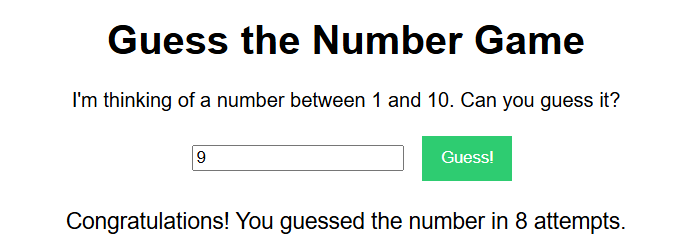Now, let’s create a fun little game called “Guess the Number.” It’s a simple game where the computer randomly picks a number, and the player has to guess it. If they guess too high or too low, they get feedback, making it engaging!
Approach
Here’s how we’ll set it up:
- HTML: We’ll create a simple interface where users can input their guesses.
- CSS: We’ll add some styles to make the game look good.
- JavaScript: We’ll implement the game logic, including random number generation and feedback for guesses.
Let’s jump into it!
1. HTML Code (index.html)
Here’s the HTML for our guessing game:
<!DOCTYPE html>
<html lang="en">
<head>
<meta charset="UTF-8">
<meta name="viewport" content="width=device-width, initial-scale=1.0">
<title>Guess the Number Game</title>
<link rel="stylesheet" href="style.css">
</head>
<body>
<h1>Guess the Number Game</h1>
<p>I'm thinking of a number between 1 and 100. Can you guess it?</p>
<input type="number" id="guess-input" placeholder="Enter your guess">
<button id="guess-button">Guess!</button>
<p id="result-message"></p>
<script src="script.js"></script>
</body>
</html>
- This HTML file sets up a title and a brief instruction for the game.
- There’s an input field for the user’s guess and a button to submit their guess.
- We also have a <p> element to display feedback messages.
2. CSS Code (style.css)
Next, let’s style our game:
body {
font-family: Arial, sans-serif;
text-align: center;
margin-top: 50px;
}
input {
margin: 10px;
}
button {
padding: 10px 15px;
background-color: #2ecc71;
color: white;
border: none;
cursor: pointer;
}
button:hover {
background-color: #27ae60;
}
#result-message {
margin-top: 20px;
font-size: 18px;
}
- The CSS makes everything look nice and clean.
- The button has a green color scheme that changes on hover, making it interactive.
- The result message is styled to stand out after the user makes a guess.
3. JavaScript Code (script.js)
Finally, here’s the JavaScript to bring the game to life:
let randomNumber = Math.floor(Math.random() * 100) + 1; // Generate random number
let attempts = 0;
document.getElementById("guess-button").addEventListener("click", () => {
const userGuess = parseInt(document.getElementById("guess-input").value);
attempts++;
const resultMessage = document.getElementById("result-message");
if (userGuess === randomNumber) {
resultMessage.textContent = `Congratulations! You guessed the number in ${attempts} attempts.`;
} else if (userGuess < randomNumber) {
resultMessage.textContent = "Too low! Try again.";
} else if (userGuess > randomNumber) {
resultMessage.textContent = "Too high! Try again.";
} else {
resultMessage.textContent = "Please enter a valid number.";
}
});
- We start by generating a random number between 1 and 10 and keep track of the number of attempts.
- When the user clicks the guess button, we get their input and increment the attempts counter.
- We check the guess against the random number and update the message accordingly.
Output



Conclusion
And there you have it! You’ve just created a “Guess the Number” game that challenges players to guess the computer’s number. This is a fantastic project to practice basic JavaScript and user interaction.
Use Cases
- Fun interactive games for educational websites.
- Basic skill-testing applications.
- Great practice for learning JavaScript fundamentals.